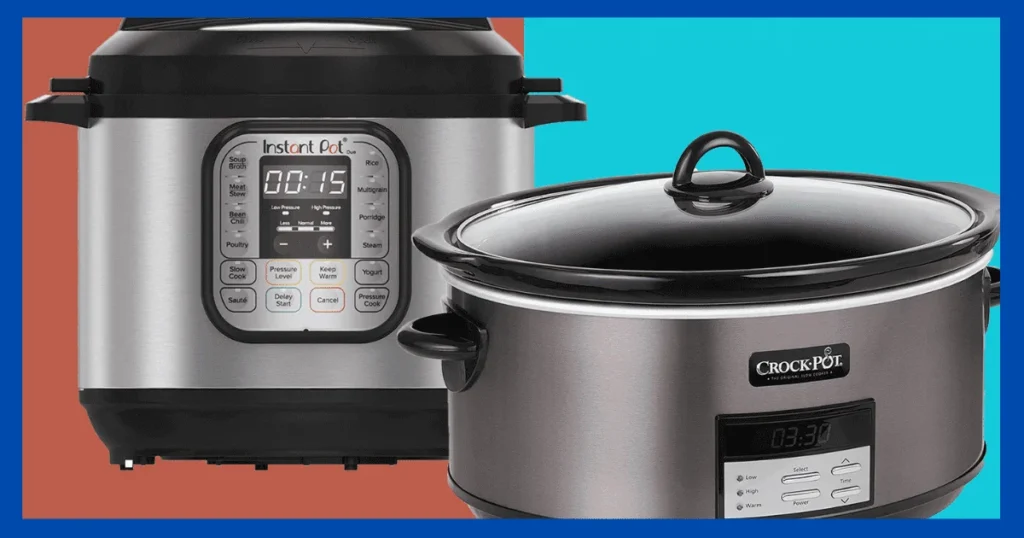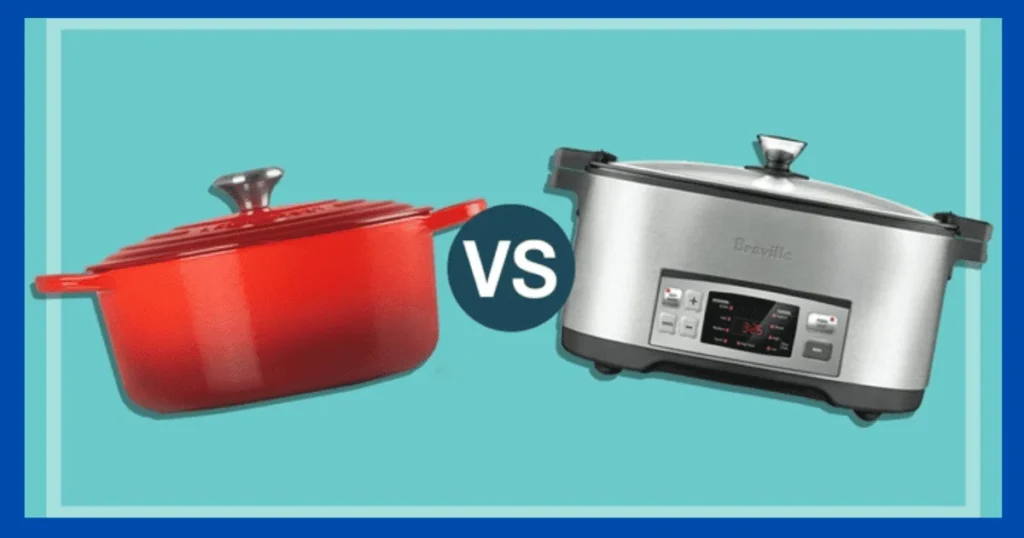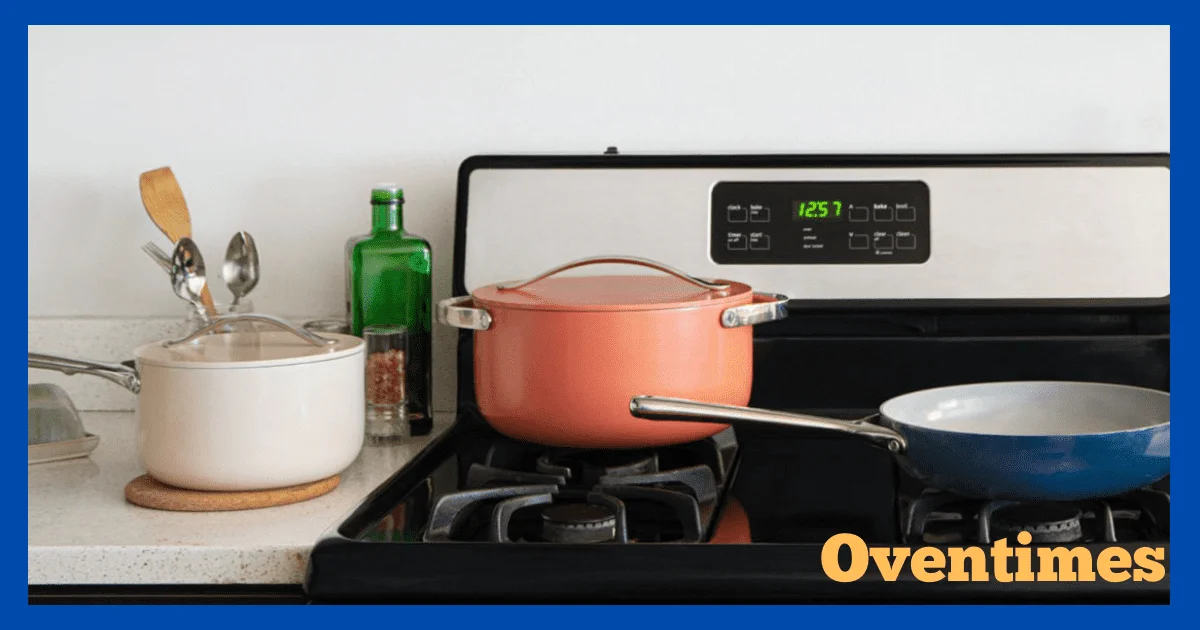A crock pot, also known as a slow cooker, is a countertop electrical cooking appliance used to simmer foods at low temperatures for long periods of time.
Crock pots cook food using direct heat from a heating element in the base of the unit, with little to no evaporation.
An oven is an enclosed, thermally insulated chamber designed for heating, baking or drying food using dry heat.
Ovens use radiant heat from heating elements to cook food evenly throughout the oven cavity. Most modern ovens have temperature controls and timers to regulate cooking.
Key Differences Between Crock Pots and Ovens

There are some key differences between how crock pots and ovens operate:
- Temperature range – Crock pots typically reach a maximum temperature of 210-280°F while ovens can reach temperatures of 500°F or higher.
- Moisture content – Crock pots cook with moisture locked in while ovens have drier heat that evaporates moisture from food.
- Air circulation – Ovens use fans to distribute hot air while crock pots have still, moist heat.
- Timing – Food cooks much more quickly at oven temperatures compared to a crock pot.
Understanding these differences in heating method and environment helps explain if and how a crock pot could be used in an oven.
Can You Safely Use a Crock Pot in the Oven?
Putting a crock pot in the oven is generally not recommended by appliance manufacturers for several important reasons:
Safety Hazards
- The crock insert and lid of a crock pot are not oven-safe. They may crack or shatter if exposed to high oven temperatures.
- Heating the base unit above the maximum design temperature can damage crock pot heating elements and electronics. This poses fire and electric shock risks.
- Most crock pot lids do not have a vent or seal. Pressure buildup from steam can cause hot food eruptions.
Food Quality Issues
- Oven temperatures will overcook foods meant for low, slow crock pot cooking. Foods may dry out, burn or scorch.
- The absence of a well-fitting lid in the oven environment allows moisture to evaporate quickly from foods.
- Inconsistent heating between the crock insert and exterior metal housing can lead to hot or cold spots.
Lack of Temperature Control
- Crock pots are not designed with thermostats to properly regulate temperature in oven environments.
- The heating element may continuously cycle on and off as it tries to compensate for oven heat.
While it’s technically possible to put a crock pot in the oven, doing so can pose safety issues and have a negative impact on the cooking results. It’s best to avoid this unconventional use.
Alternative Methods to Achieve Slow Cooked Flavors
While you should avoid putting your crock pot in the oven, there are some good alternative options to achieve delicious slow cooked flavors using traditional oven-safe cookware:
Use a Dutch Oven or Casserole Dish with Lid
Heavy, thick-walled pots like Dutch ovens or casserole dishes with tight fitting lids can replicate moist, low heat environments. Choose an oven-safe cooking vessel and use low oven temperatures of 300-325°F. Add liquid as needed to prevent drying out.
Try a Slow Cooker Function on Multi-Cookers
Many new multi-function pressure cookers have a dedicated slow cook mode with temperature control suitable for oven use up to 400°F. Cook time may need adjusting.
Make Foods Ahead and Reheat in Oven
Get the benefits of long, moist crock pot cooking by preparing foods a day ahead. Refrigerate cooked food then reheat servings covered in oven-safe dishes at 250-300°F.
Use Liquid to Prevent Drying Out
If oven-cooking or reheating crock pot-style dishes, add extra liquid or cover food to prevent moisture loss in the dry oven heat. Stock, wine, broth, or water in a covered baking dish or foil tent can help maintain tender textures.
With the right oven-safe cookware and techniques, you can adapt most crock pot recipes for the oven. Avoid the risks of putting a real crock pot in the oven but replicate the delicious results using suitable alternatives.
Tips for Safely Using a Crock Pot
While crock pots aren’t suitable for oven use, they can produce delicious slow cooked meals when used properly. Here are some top tips:
- Mind maximum fill lines – Don’t overfill crock inserts as boiling liquids can bubble over.
- Keep it covered – Use the lid to retain moisture and allow food to cook gently.
- Give a stir occasionally – Check food and stir periodically to prevent scorching on sides.
- Bring to a boil on the stove first – Browning meat or simmering sauce gets recipes started faster.
- Use residual heat – When done, food will keep warming over residual heat left in the pot.
- Transport with care – Only move the crock pot once cooled and grasp both the ceramic insert and base together.
Following basic safety precautions will allow you to enjoy all the benefits of slow cooking in an authentic crock pot appliance.
Comparison of Cooking in Crock Pots vs Ovens
| Factor | Crock Pot | Oven |
|---|---|---|
| Temperature Range | Low: 200-250°F High: 209-280°F | Ranges from 200-550°F+ |
| Heating Method | Electric heating element in base | Electrical heating coils or gas burners |
| Direct conduction through ceramic | Hot air circulation | |
| Moisture Level | Moist heat from contained liquids | Dry heat evaporates moisture |
| Air Circulation | Still, moist air | Moving hot air with fans |
| Lid retains moisture | Vents allow moisture to escape | |
| Cooking Time | Very slow – Up to 10+ hours | Much faster at high temps |
| Food Texture | Fall-off-the-bone tender and moist | Can dry out without liquid |
| Food Safety | Below bacterial danger zone | Risk of bacteria at low temps |
| Energy Use | Uses less energy | Ovens use more electricity or gas |
| Convenience | Set it and forget it ease | More active cooking time |
When Should You Use Each Method?

Best Uses for Crock Pots
- Tough, cheap cuts of meat becoming tender
- All-day simmered beans, stocks, soups
- Unattended cooking times
- Minimal prep recipes
- Serving food warm throughout the day
Best Uses for Ovens
- High heat searing, baking, roasting
- Quick cooking times
- Foods that need dry air like breads
- Active cooking with more preparation
- Meals cooked immediately before eating
Conclusion
While it’s not recommended to put a crock pot in the oven due to safety and cooking issues, you can still make delicious slow cooked meals in the oven with the right techniques. Choose oven-safe vessels, utilise moist heat methods, and adjust cooking times for the higher temperatures. Or simply stick to using your crock pot as intended on the countertop for that classic, tender flavor when you don’t want to actively monitor cooking.
Frequently Asked Questions
Here are some frequently asked question given below:
Can you put a ceramic crock pot in the oven?
No, ceramic crock pots should never be put in the oven. The crock insert and lid are made from glazed ceramic that will likely crack or shatter under high oven heat. The metal housing and electrical components are also not built to withstand oven temperatures.
What happens if you put a crock pot in the oven?
Putting a real crock pot in the oven risks damaging the ceramic insert, lid, heating element, and electronics. The food may overcook from high heat. Pressure buildup could also cause hot liquid eruptions if venting steam cannot escape.
Can I use a crock pot as an oven?
A regular crock pot is not designed to function as a replacement for an oven. While it uses heating elements to cook food, a crock pot lacks proper temperature controls, ventilation, and the structure to reach and maintain high oven-like temperatures.
Is it safe to cook in a crock pot on high?
Yes, using the high setting on a crock pot is safe provided you follow the manufacturer’s instructions. High typically reaches temperatures between 209-280°F – hot enough to boil liquids or cook food through, but not hot enough to mimic an oven.
Can I bake in a crock pot?
No, a crock pot does not get hot enough or provide the dry, circulating air needed for proper baking. Breads and cakes baked in a crock pot often end up pale, dense, and undercooked. Use a real oven for baking best results.
